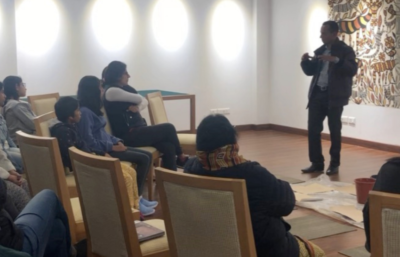
In Karanpur Valley of the Vindhyan Hill Chain where the Damodar River flows, is the Sati Range, wherein lie the villages of Ganju and Kurmi. The tribals live there in peace and seclusion and the villagers paint vivid images birds, animals and plant life on the walls of their houses. The Traditional mural painting tradition is done throughout Hazaribagh district. However, the Khovar art is done exclusively in Jorakath, and Kharati village in Barkagaon block in south-west Hazaribagh, While Sohrai art is done in Bhelwara village in Bishungarh block in east Hazaribagh. Stylistically, the women artists in the hills paint animals and birds, While those in the valley paint plants, aquatic life, and birds, etc..Painted Houses of Hazaribagh
Justin Imam of Virasat Trust gave the World Spa resident community a lecture on the sustainable art forms of Khovar and Sohrai and it’s historical significance that traces it’s roots back to a Mesolithic Period. The Hazaribagh region in Jharkhand is a heavily forested plateau with deep river valleys, and exotic forest tribes. This area has been found to have magnificent Mesolithic rock art (10,000 B.C) , that may be directly traced as the distant ancestor of a unique style of wall paintings in the villages of Hazaribagh.
This resulted an engaged discussion that built knowledge and value of the art practice and community adoption.
It is important that all of us as part of a community come together and contribute for a better
future for us and our environment.